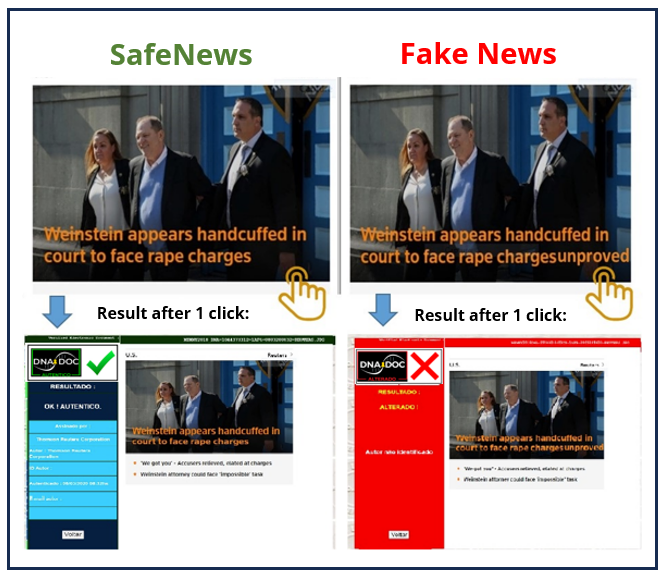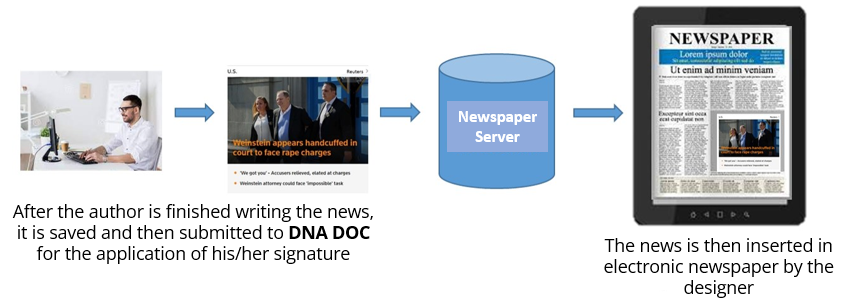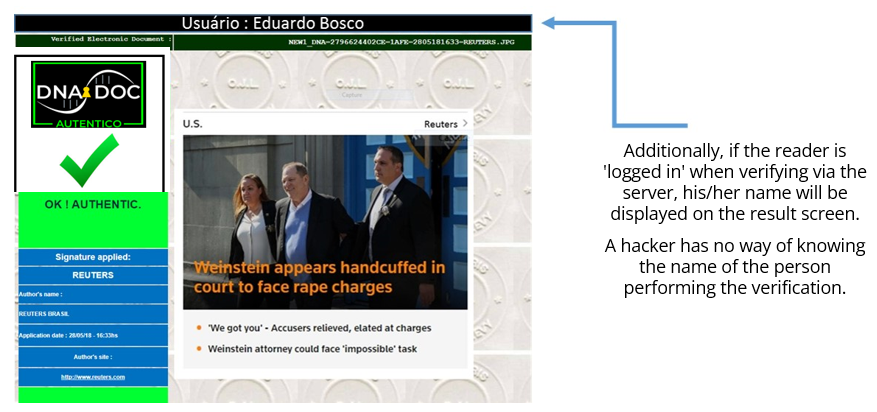


Authenticity verification with just 1 click. For digital newspapers and social networks.

SafeNews is a dedicated technology from DNA DOC
We call SafeNews any news or information that carries in itself its origin (author), date and time of generation. By clicking on the news itself, verification is performed on the certified servers and in a few seconds the reader receives the answer: if it is Authentic, the name of the author (and/or company) plus its date and time of authentication is displayed. If it is not authentic, the response indicates that the news is false or has been Altered.
"All information without the identification of source and author does not deserve credibility. Fake News is the modern term for rumor, defamation and lies whose authors hide in anonymity. SafeNews makes it possible is to separate identifiable and responsible information from anonymous information."
Eduardo Bosco

It’s as simple as that:
The SafeNews verification system uses only the news itself to verify its integrity and authenticity. No kind of comparison is performed with other files. A SafeNews file is stand-alone and can be similarly scanned by any third-party server/computer that has installed the scanning service module.

The author of the news (after combining any desired texts, images and videos) records the news as an electronic file in any format defined by the publisher. After saving it, the author ‘signs’ the news with his password. The transmit/publish command triggers a dynamic Token, which enables the absolute security of the transmission. The Token generated is valid for 1 minute.

Each electronic news outlet (newspaper, social networks, etc.) will choose its preferred form of verification:
A SafeNews news can be scanned on any server in the world that installs the verification program. The news carries within itself its identity and authenticity.
Even if an author receives a new signature key, all news published with the previous key remains with the SafeNews security applied.
Therefore, the exchange for a new key inhibits the use of the previous key to apply SafeNews to the new articles.
Newspapers may include their name -along with the signature of the author of the news- at their discretion. When registering as a SafeNews author, this option will be offered.

Hackers could, in theory, succeed in breaking into the newspapers' servers and change the verification link.
Every news transmission from the author to the server uses a dynamic Token:
The SafeNews system does not have a news database to be able to make comparisons. The news is stand-alone and is stored on the authors' computers. In fact, it doesn't matter what has been modified. The value of SafeNews is precisely to identify if there was even the slightest alteration or not. When it has NOT been tampered with, the author, date and time of the publication of the news is revealed.
Some points that deserve attention:
1) Through a touch menu/pop-up function.
2) By a simple click on the news.
3) By downloading the news and verifying it on the SafeNews website.
Only the authors of the news will pay for the authentication service. Verification is free and unlimited.
No. The only requirement we make is that the name of the file containing the news is not changed. One part of the security key is included in the file name.
The reasons why a SafeNews story can only be verified as an archive (file) and not with single words are:

By not storing news, the SafeNews system democratizes information. The actual news carries the ability to reveal itself as authentic or false. With SafeNews, we will finally manage to eradicate Fake News.